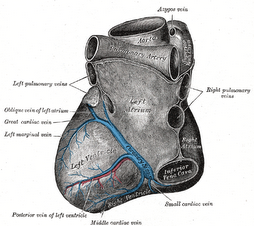
Characteristics
Normal activation of the left ventricle proceeds down the left bundle branch, which consist of two fascicles the left anterior fascicle and left posterior fascicle. Left Anterior Fascicular Block (LAFB), which is also known as Left Anterior Hemiblock (LAHB), occurs when a cardiac impulse spreads first through the left posterior fascicle, causing a delay in activation of the anterior and lateral walls of the left ventricle which are normally activated via the left anterior fascicle.
Although there is a delay or block in activation of the left anterior fascicle there is still preservation of initial left to right septal activation as well as preservation of the inferior activation of the left ventricule (preservation of septal Q waves in I and aVL and small initial R wave in leads II, III, and aVF). The delayed and unopposed activation of the remainder of the left ventricle now results in a shift in the QRS axis leftward and superiorly, causing marked left axis deviation. This delayed activation also results in a widening of the QRS complex, although not to the extent of a complete LBBB
Criteria for LAFB
- Left axis deviation (usually between -45° and -90°), some consider -30° to meet criteria
- QRS interval less than 120ms
- qR complex in the lateral limb leads (I and aVL)
- rS pattern in the inferior leads (II, III, and aVF)
- Delayed intrinsicoid deflection in lead aVL (> 0.045 s)
ExceptionsIt is important not to call LAFB in the setting of a prior inferior wall myocardial infarction which may also demonstrate left axis deviation due to the '''initial forces''' (Q wave in a Qr complex) in leads II, III, and aVF. As opposed to LAHB, the left axis shift is due to '''terminal forces''' (i.e., the S wave in an rS complex) being directed superiorly,
Effects of LAHB on Diagnosing Infarctions and Left Ventricular HypertrophyLAHB may be a cause of poor R wave progression across the precordium causing a pseudoinfarction pattern mimicking an anteroseptal infarction. It also makes the electrocardiographic diagnosis of LVH more complicated, because both may cause a large R wave in lead aVL. Therefore to call LVH on an EKG in the setting of an LAHB you should see the presence of a “strain” pattern when you are relying on limb lead criteria to diagnose LVH.
Clinical Significance - It is seen in approximately 4% of cases of acute myocardial infarction
- It is the most common type of intraventricular conduction defect seen in acute anterior myocardial infarction, and the left anterior descending artery is usually the culprit vessel.
- It can be seen with acute inferior wall myocardial infarction.
- It also associated with hypertensive heart disease, aortic valvular disease, cardiomyopathies, and degenerative fibrotic disease of the cardiac skeleton.
References - Mirvis DM, Goldberger AL. Electrocardiography. In: Braunwald E, Zipes DP, Libby P, eds. Heart disease: a textbook of cardiovascular medicine, 6th edn. Philadelphia: WB Saunders; 2001:82–125.
- Surawicz B, Knilans TK. Chou’s electrocardiography in clinical practice: adult and pediatric, 5th edn. Philadelphia: W.B. Saunders; 2001.







